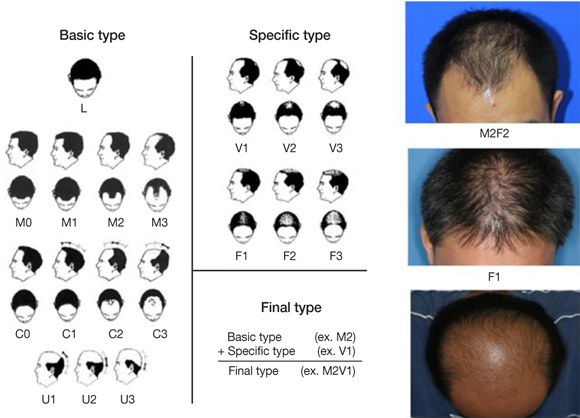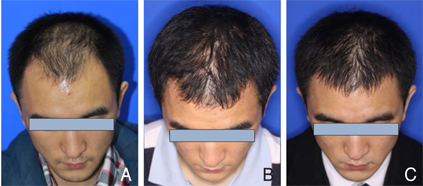J Korean Med Assoc.
2013 Jan;56(1):45-54. 10.5124/jkma.2013.56.1.45.
Hair characteristics and androgenetic alopecia in Koreans
- Affiliations
-
- 1Department of Dermatology, Inha University School of Medicine, Incheon, Korea. garden@inha.ac.kr
- KMID: 2192900
- DOI: http://doi.org/10.5124/jkma.2013.56.1.45
Abstract
- The scalp hair is composed of one hundred thousand of hairs. Each hair goes through the three phases of the hair cycle, which causes the hair to turn from an anagen hair into a catagen hair, then into a telogen hair, and finally into a new anagen hair. The number of hairs is maintained at a relatively constant level because each hair has its own hair cycle. The hair of Koreans is relatively thicker than that of Caucasians and Africans but its growth rate and density are lower. There are various factors that influence hair growth such as hormones, nutritional status, and drugs. However, androgen is most important among these factors and, particularly, androgenetic alopecia is caused by androgen and genetic factors. Because excessive dihydrotestosterone produced by 5alpha-reductase is of the greatest importance in androgenetic alopecia, finasteride or dutasteride, which inhibits the action of 5alpha-reductase, is effective in treating androgenetic alopecia. Also, minoxidil is widely used as it promotes hair growth. Furthermore, there are various types of hair diseases and specialized examination is required for differential diagnosis.
Keyword
MeSH Terms
Figure
Cited by 1 articles
-
Safety and Tolerability of the Dual 5-Alpha Reductase Inhibitor Dutasteride in the Treatment of Androgenetic Alopecia
Gwang Seong Choi, Joon Hyung Kim, Shin-Young Oh, Jung-Min Park, Ji-Soo Hong, Yil-Seob Lee, Won-Soo Lee
Ann Dermatol. 2016;28(4):444-450. doi: 10.5021/ad.2016.28.4.444.
Reference
-
1. Cotsarelis G, Botchkarev V. Disorders of the hair and nails. In : Wolff K, Goldsmith LA, Katz SI, Gilchrest BA, Paller AS, Leffell DJ, editors. Fitzpatrick's dermatology in general medicine. 7th ed. New York: McGraw-Hill;2008. p. 739–749.2. Cotsarelis G, Millar SE, Chan EF. Embryology and anatomy of the hair follicle. In : Olsen EA, editor. Disorders of hair growth: diagnosis and treatment. 2nd ed. New York: McGraw-Hill;2003. p. 15.3. Shapiro J. Hair loss: principles of diagnosis and management of alopecia. London: Martin Dunitz;2002.4. Wolfram LJ, Dika E, Maibach HI. Hair anthropology. In : Berardesca E, Leveque JL, Maibach HI, editors. Ethnic skin and hair. New York: Informa Healthcare;2006. p. 55–67.5. Tajima M, Hamada C, Arai T, Miyazawa M, Shibata R, Ishino A. Characteristic features of Japanese women's hair with aging and with progressing hair loss. J Dermatol Sci. 2007; 45:93–103.
Article6. Birch MP, Messenger JF, Messenger AG. Hair density, hair diameter and the prevalence of female pattern hair loss. Br J Dermatol. 2001; 144:297–304.
Article7. Yoo JH, Park HY, Park TH, Kim KJ. Quantitative analysis on the scalp hair characteristics in Koreans using phototrichogram. Korean J Dermatol. 2002; 40:1035–1043.8. Kang H, Kang TW, Lee SD, Park YM, Kim HO, Kim SY. The changing patterns of hair density and thickness in South Korean women with hair loss: clinical office-based phototri-chogram analysis. Int J Dermatol. 2009; 48:14–21.
Article9. Stenn KS, Paus R. Controls of hair follicle cycling. Physiol Rev. 2001; 81:449–494.
Article10. Paus R, Muller-Rover S, Botchkarev VA. Chronobiology of the hair follicle: hunting the "hair cycle clock". J Investig Dermatol Symp Proc. 1999; 4:338–345.
Article11. Rushton H, James KC, Mortimer CH. The unit area trichogram in the assessment of androgen-dependent alopecia. Br J Dermatol. 1983; 109:429–437.
Article12. Park YT, Yoo JH, Park TH, Kim KJ. Comparative evaluation of hair density and grouped hair unit pattern between androge-netic alopecia and normal scalp. Ann Dermatol. 2004; 16:1–8.
Article13. Haw S, Lew BL, Sim WY. The study of density and thickness of Koreans' scalp hair with aging. Korean J Dermatol. 2008; 46:Suppl 2. 161.14. Park J, Ihm CW. Evaluation of the scalp hair mass of Koreans. Korean J Dermatol. 2010; 48:17–25.15. Zouboulis CC, Chen WC, Thornton MJ, Qin K, Rosenfield R. Sexual hormones in human skin. Horm Metab Res. 2007; 39:85–95.
Article16. Shah D, Patel S. Hirsutism. Gynecol Endocrinol. 2009; 25:140–148.
Article17. Alonso LC, Rosenfield RL. Molecular genetic and endocrine mechanisms of hair growth. Horm Res. 2003; 60:1–13.
Article18. Whiting DA. Possible mechanisms of miniaturization during androgenetic alopecia or pattern hair loss. J Am Acad Dermatol. 2001; 45:S81–S86.
Article19. Hoffmann R. Male androgenetic alopecia. Clin Exp Dermatol. 2002; 27:373–382.
Article20. Randall VA. Androgens and hair growth. Dermatol Ther. 2008; 21:314–328.
Article21. Goldberg LJ, Lenzy Y. Nutrition and hair. Clin Dermatol. 2010; 28:412–419.
Article22. Olsen EA. Iron deficiency and hair loss: the jury is still out. J Am Acad Dermatol. 2006; 54:903–906.
Article23. Muller O, Krawinkel M. Malnutrition and health in developing countries. CMAJ. 2005; 173:279–286.
Article24. Bolland MJ, Ames RW, Grey AB, Horne AM, Mason BH, Gamble GD, Reid IR. Does degree of baldness influence vita-min D status? Med J Aust. 2008; 189:674–675.
Article25. Tosi A, Misciali C, Piraccini BM, Peluso AM, Bardazzi F. Drug-induced hair loss and hair growth: incidence, management and avoidance. Drug Saf. 1994; 10:310–317.26. Tosti A, Pazzaglia M. Drug reactions affecting hair: diagnosis. Dermatol Clin. 2007; 25:223–231.
Article27. Hamilton JB. Male hormone stimulation is prerequisite and an incitant in common baldness. Am J Anat. 1942; 71:451–480.
Article28. Hoffmann R. Steroidogenic isoenzymes in human hair and their potential role in androgenetic alopecia. Dermatology. 2003; 206:85–95.
Article29. Lee WS, Oh Y, Ji JH, Park JK, Kim do W, Sim WY, Kim HO, Hwang SW, Yoon TY, Kye YC, Choi GS, Kim MB, Huh CH, Ro BI, Kim SJ, Kim JH, Lee Y. Analysis of familial factors using the basic and specific (BASP) classification in Korean patients with androgenetic alopecia. J Am Acad Dermatol. 2011; 65:40–47.
Article30. Hillmer AM, Flaquer A, Hanneken S, Eigelshoven S, Kortum AK, Brockschmidt FF, Golla A, Metzen C, Thiele H, Kolberg S, Reinartz R, Betz RC, Ruzicka T, Hennies HC, Kruse R, Nothen MM. Genome-wide scan and fine-mapping linkage study of androgenetic alopecia reveals a locus on chromosome 3q26. Am J Hum Genet. 2008; 82:737–743.
Article31. Inui S, Itami S. Molecular basis of androgenetic alopecia: from androgen to paracrine mediators through dermal papilla. J Dermatol Sci. 2011; 61:1–6.
Article32. Lee WS, Ro BI, Hong SP, Bak H, Sim WY, Kim do W, Park JK, Ihm CW, Eun HC, Kwon OS, Choi GS, Kye YC, Yoon TY, Kim SJ, Kim HO, Kang H, Goo J, Ahn SY, Kim M, Jeon SY, Oh TH. A new classification of pattern hair loss that is universal for men and women: basic and specific (BASP) classification. J Am Acad Dermatol. 2007; 57:37–46.
Article33. Olsen EA, Dunlap FE, Funicella T, Koperski JA, Swinehart JM, Tschen EH, Trancik RJ. A randomized clinical trial of 5% topical minoxidil versus 2% topical minoxidil and placebo in the treatment of androgenetic alopecia in men. J Am Acad Dermatol. 2002; 47:377–385.
Article34. Park HY, Lee WS, Park J, Kim DW, Ahn SY, Jung YJ, Ro BI, Sim WY, Park SW, Choi GS, Kim HO, Huh CH, Yoon TY, Kim MB, Kim KH, Song H, Yun SJ. An open label, multi-center clinical trial of topical 5% minoxidil solution for the treatment of male androgenetic alopecia (a phase IV study). Korean J Dermatol. 2009; 47:295–302.35. Kaufman KD, Olsen EA, Whiting D, Savin R, DeVillez R, Bergfeld W, Price VH, Van Neste D, Roberts JL, Hordinsky M, Shapiro J, Binkowitz B, Gormley GJ. Finasteride Male Pattern Hair Loss Study Group. Finasteride in the treatment of men with androgenetic alopecia. J Am Acad Dermatol. 1998; 39(4 Pt 1):578–589.
Article36. Finasteride Male Pattern Hair Loss Study Group. Long-term (5-year) multinational experience with finasteride 1 mg in the treatment of men with androgenetic alopecia. Eur J Dermatol. 2002; 12:38–49.37. Kaufman KD, Rotonda J, Shah AK, Meehan AG. Long-term treatment with finasteride 1 mg decreases the likelihood of developing further visible hair loss in men with androgenetic alopecia (male pattern hair loss). Eur J Dermatol. 2008; 18:400–406.38. Olsen EA, Hordinsky M, Whiting D, Stough D, Hobbs S, Ellis ML, Wilson T, Rittmaster RS. Dutasteride Alopecia Research Team. The importance of dual 5alpha-reductase inhibition in the treatment of male pattern hair loss: results of a random-ized placebo-controlled study of dutasteride versus finaste-ride. J Am Acad Dermatol. 2006; 55:1014–1023.
Article39. Eun HC, Kwon OS, Yeon JH, Shin HS, Kim BY, Ro BI, Cho HK, Sim WY, Lew BL, Lee WS, Park HY, Hong SP, Ji JH. Efficacy, safety, and tolerability of dutasteride 0.5 mg once daily in male patients with male pattern hair loss: a randomized, double-blind, placebo-controlled, phase III study. J Am Acad Dermatol. 2010; 63:252–258.
Article40. Olsen EA. Female pattern hair loss. J Am Acad Dermatol. 2001; 45:3 Suppl. S70–S80.
Article






